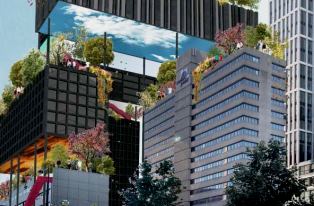 Wonen in het hart van de stad, midden in de stedelijke ‘vibe’, is weer in. Dat betekent dat steden voor een uitdagende verdichtingsopgave staan. Zo ook Rotterdam. In Licht Verdicht, een onderzoek naar verdichten door optoppen, keken zeven multidisciplinaire ontwerpteams hoe zij de Rotterdamse binnenstad letterlijk naar grotere hoogte kunnen brengen. Het boek laat zien hoe nieuwe ruimte kan worden gecreëerd bovenop de oude reuzen die er al staan.
Wonen in het hart van de stad, midden in de stedelijke ‘vibe’, is weer in. Dat betekent dat steden voor een uitdagende verdichtingsopgave staan. Zo ook Rotterdam. In Licht Verdicht, een onderzoek naar verdichten door optoppen, keken zeven multidisciplinaire ontwerpteams hoe zij de Rotterdamse binnenstad letterlijk naar grotere hoogte kunnen brengen. Het boek laat zien hoe nieuwe ruimte kan worden gecreëerd bovenop de oude reuzen die er al staan.
Op donderdag 11 mei heeft BNA Onderzoek in samenwerking met NAi Boekverkopers de bijeenkomst Licht Verdicht – Grensverleggende ideeën voor optoppen in de binnenstad van Rotterdam georganiseerd. De presentatie van de ontwerpstudie naar het optoppen van bestaande gebouwen in stadscentrum Rotterdam en het hieruit resulterende boek Licht Verdicht stonden centraal.
The Tallest Buildings Per State
 We all know that the skyscraper was born between Chicago and New York (depending on who you ask or what you consider a skyscraper, but that’s for another discussion). But what about the rest of the US? How does each state stack up in the race towards the sky? This infographic by highrises.com gives us a scaled approximation of the “height” of each state–with New York coming out on top and Vermont, well… Vermont’s tallest building is an 11-story public housing project built in the 70s. The infographic also breaks down the purposes of the surveyed buildings, revealing that nearly 2% of the tallest buildings in each state are churches! Another interesting factoid? Nearly 1/3 of these highrises are named after banks.
We all know that the skyscraper was born between Chicago and New York (depending on who you ask or what you consider a skyscraper, but that’s for another discussion). But what about the rest of the US? How does each state stack up in the race towards the sky? This infographic by highrises.com gives us a scaled approximation of the “height” of each state–with New York coming out on top and Vermont, well… Vermont’s tallest building is an 11-story public housing project built in the 70s. The infographic also breaks down the purposes of the surveyed buildings, revealing that nearly 2% of the tallest buildings in each state are churches! Another interesting factoid? Nearly 1/3 of these highrises are named after banks.
Utrecht kiest voor veel hoogbouw
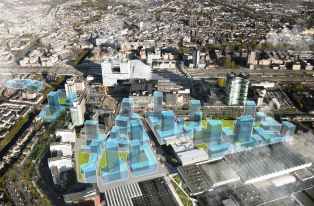 Utrecht heeft voor het nieuwe centrum gekozen voor hoogbouw, groen en duurzaamheid. Op het toekomstige Beurskwartier, Lombokplein en Jaarbeursterrein komen 3.600 woningen. Hiervoor gaan wel woningen aan de Croeselaan gesloopt worden. Dat heeft wethouder Victor Everhardt bekendgemaakt met de zogeheten ‘Conceptomgevingsvisie’. In 2030 ziet de stad er compleet anders uit. Om deze ontwikkeling in gang te zetten is er al een aantal knopen doorgehakt. Lees verder >>>
Utrecht heeft voor het nieuwe centrum gekozen voor hoogbouw, groen en duurzaamheid. Op het toekomstige Beurskwartier, Lombokplein en Jaarbeursterrein komen 3.600 woningen. Hiervoor gaan wel woningen aan de Croeselaan gesloopt worden. Dat heeft wethouder Victor Everhardt bekendgemaakt met de zogeheten ‘Conceptomgevingsvisie’. In 2030 ziet de stad er compleet anders uit. Om deze ontwikkeling in gang te zetten is er al een aantal knopen doorgehakt. Lees verder >>>
DvdA Den Haag
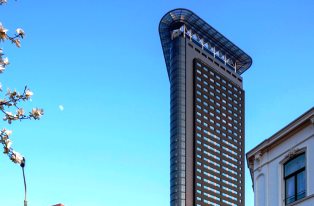 De Dag van de Architectuur is oorspronkelijk een initiatief van de Bond van Nederlandse Architecten (BNA). In Den Haag wordt het programma samengesteld door de Stichting Dag van de Architectuur Den Haag in samenwerking met BNA Kring Haaglanden, Haags Architectuur Café (HaAC), Den Haag ArchiGuides, Platform STAD en gemeente Den Haag. De Dag van de Architectuur vindt plaats op zaterdag 20 mei. Er vinden diverse rondleidingen plaats in en langs de hoogbouw van Den Haag!
De Dag van de Architectuur is oorspronkelijk een initiatief van de Bond van Nederlandse Architecten (BNA). In Den Haag wordt het programma samengesteld door de Stichting Dag van de Architectuur Den Haag in samenwerking met BNA Kring Haaglanden, Haags Architectuur Café (HaAC), Den Haag ArchiGuides, Platform STAD en gemeente Den Haag. De Dag van de Architectuur vindt plaats op zaterdag 20 mei. Er vinden diverse rondleidingen plaats in en langs de hoogbouw van Den Haag!
Winners 2017 Skyscraper Competition
 eVolo Magazine is pleased to announce the winners of the 2017 Skyscraper Competition. The Jury selected 3 winners and 22 honorable mentions from 444 projects received. The annual award established in 2006 recognizes visionary ideas for building high- projects that through the novel novel use of technology, materials, programs, aesthetics, and spatial organizations, challenge the way we understand vertical architecture and its relationship with the natural and built environments. Read on >>>
eVolo Magazine is pleased to announce the winners of the 2017 Skyscraper Competition. The Jury selected 3 winners and 22 honorable mentions from 444 projects received. The annual award established in 2006 recognizes visionary ideas for building high- projects that through the novel novel use of technology, materials, programs, aesthetics, and spatial organizations, challenge the way we understand vertical architecture and its relationship with the natural and built environments. Read on >>>
Berlins neue Skyline
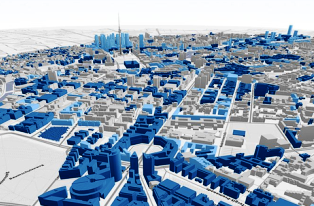 Berlin hat keine echte Skyline. Noch nicht. Allenfalls der Fernsehturm ragt mit 368 Metern wirklich weit in den Hauptstadthimmel. Wolkenkratzer gibt es kaum: Nur fünf Hochhäuser mit mehr als 100 Metern Höhe stehen weit verstreut in der Innenstadt. Ein Berliner Höhenwachstum ist seit Jahrzehnten umstritten – und bleibt es: »Der Markt für die Entwicklung von Hochhäusern ist in Berlin begrenzt«, sagt Berlins Chef-Stadtplanerin Regula Lüscher. Doch viele Architekten streben nach neuen Höhen. In der 3D-Visualisierung können Sie nachvollziehen, wie sich die Berliner Innenstadt seit 1990 verändert hat – und wie sie in Zukunft aussehen soll.
Berlin hat keine echte Skyline. Noch nicht. Allenfalls der Fernsehturm ragt mit 368 Metern wirklich weit in den Hauptstadthimmel. Wolkenkratzer gibt es kaum: Nur fünf Hochhäuser mit mehr als 100 Metern Höhe stehen weit verstreut in der Innenstadt. Ein Berliner Höhenwachstum ist seit Jahrzehnten umstritten – und bleibt es: »Der Markt für die Entwicklung von Hochhäusern ist in Berlin begrenzt«, sagt Berlins Chef-Stadtplanerin Regula Lüscher. Doch viele Architekten streben nach neuen Höhen. In der 3D-Visualisierung können Sie nachvollziehen, wie sich die Berliner Innenstadt seit 1990 verändert hat – und wie sie in Zukunft aussehen soll.
The Manhattan of the Desert
 In the heart of Yemen’s Wadi Hadramaut, a cluster of ancient mud skyscrapers soars above the desert floor—a beacon of mankind’s adaptability to the most formidable of environments.
In the heart of Yemen’s Wadi Hadramaut, a cluster of ancient mud skyscrapers soars above the desert floor—a beacon of mankind’s adaptability to the most formidable of environments.
At the edge of a desolate expanse of desert known as the Empty Quarter, the 16th-century Walled City of Shibam remains the oldest metropolis in the world to use vertical construction. Once a significant caravan stop on the spice and incense route across the southern Arabian plateau, British explorer Freya Stark dubbed the mud city “the Manhattan of the desert” in the 1930s. Read on This ancient mud skyscraper city is the ‘Manhattan of the Desert’.
Hoogstedelijk Wonen: Sluisbuurt
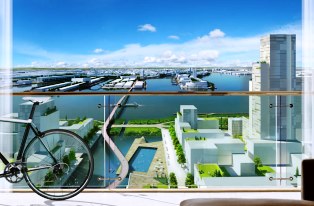 Het ontwikkelen van aantrekkelijke hoogstedelijke woonmilieus is een belangrijke opgave voor de komende jaren. Bovendien is er volop debat over het thema, onder meer naar aanleiding van de te ontwikkelen Sluisbuurt in Amsterdam. Om van elkaars visie en ervaring te leren, wordt op de Dag van de Projectontwikkeling in gesprek gegaan over het ontwerpen en ontwikkelen van dergelijke woonmilieus aan de hand van presentaties over stedenbouw en over gebouwconcepten en woningtypen. Een belangrijk deel van de voor 2030 te realiseren één miljoen nieuwe woningen moet binnen bestaand stedelijk gebied landen. Steeds meer hoog opgeleide, jonge, veelal eenpersoons-huishoudens voelen zich aangetrokken tot het stedelijk leven en zij kiezen steeds vaker voor een relatief klein appartement in een gebouw met services en een voorzieningenrijke buurt. Een belangrijke opgave voor de komende jaren ligt in het ontwikkelen van voor deze doelgroep aantrekkelijke hoogstedelijke woonmilieus, onder andere door transformatie en herontwikkeling van binnenstedelijke gebieden. Maar ook stedelijk georiënteerde gezinnen en senioren moeten zich in die woonmilieus thuis kunnen voelen. Ontwikkelaars kunnen en moeten daar belangrijke bijdragen aan leveren. Zie ook het Manifest Binnenstedelijke Gebiedstransformaties. De nieuw te ontwikkelen Sluisbuurt op het Zeeburgereiland in Amsterdam is zo’n actuele opgave, waar veel debat en denkkracht over loskomt. Zie hiervoor de site van de gemeente Amsterdam over Sluisbuurt, maar ook het artikel in het NRC waarin de ambities van de gemeente ter discussie worden gesteld.
Het ontwikkelen van aantrekkelijke hoogstedelijke woonmilieus is een belangrijke opgave voor de komende jaren. Bovendien is er volop debat over het thema, onder meer naar aanleiding van de te ontwikkelen Sluisbuurt in Amsterdam. Om van elkaars visie en ervaring te leren, wordt op de Dag van de Projectontwikkeling in gesprek gegaan over het ontwerpen en ontwikkelen van dergelijke woonmilieus aan de hand van presentaties over stedenbouw en over gebouwconcepten en woningtypen. Een belangrijk deel van de voor 2030 te realiseren één miljoen nieuwe woningen moet binnen bestaand stedelijk gebied landen. Steeds meer hoog opgeleide, jonge, veelal eenpersoons-huishoudens voelen zich aangetrokken tot het stedelijk leven en zij kiezen steeds vaker voor een relatief klein appartement in een gebouw met services en een voorzieningenrijke buurt. Een belangrijke opgave voor de komende jaren ligt in het ontwikkelen van voor deze doelgroep aantrekkelijke hoogstedelijke woonmilieus, onder andere door transformatie en herontwikkeling van binnenstedelijke gebieden. Maar ook stedelijk georiënteerde gezinnen en senioren moeten zich in die woonmilieus thuis kunnen voelen. Ontwikkelaars kunnen en moeten daar belangrijke bijdragen aan leveren. Zie ook het Manifest Binnenstedelijke Gebiedstransformaties. De nieuw te ontwikkelen Sluisbuurt op het Zeeburgereiland in Amsterdam is zo’n actuele opgave, waar veel debat en denkkracht over loskomt. Zie hiervoor de site van de gemeente Amsterdam over Sluisbuurt, maar ook het artikel in het NRC waarin de ambities van de gemeente ter discussie worden gesteld.Debat hoogbouw II
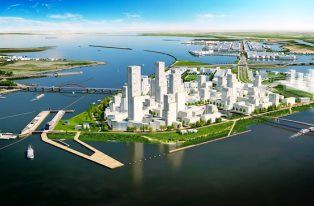 Op 28 maart heeft een vervolg op het ‘Debat Hoogbouw: the sky, the limit?’ plaatsgevonden in de Tolhuistuin in Amsterdam. Tijs van den Boomen schreef naar aanleiding van het debat ‘Een blokkenstad met torens‘.
Op 28 maart heeft een vervolg op het ‘Debat Hoogbouw: the sky, the limit?’ plaatsgevonden in de Tolhuistuin in Amsterdam. Tijs van den Boomen schreef naar aanleiding van het debat ‘Een blokkenstad met torens‘.
